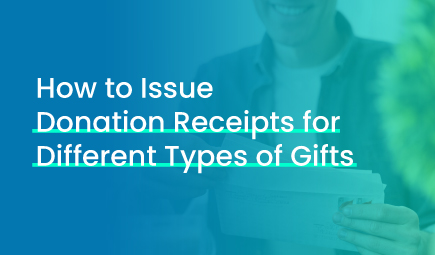 Imagine you’re opening a nonprofit thrift store. With the help of generous donors, you’ve secured funding, rented retail space, and sourced inventory. Before opening to the public, you just have to nail down the finer details of your store’s operations, including your thrift store pricing strategy and layout.
Imagine you’re opening a nonprofit thrift store. With the help of generous donors, you’ve secured funding, rented retail space, and sourced inventory. Before opening to the public, you just have to nail down the finer details of your store’s operations, including your thrift store pricing strategy and layout.
Although you’ve done a lot of work to establish your store, none of it would be possible without the donors who have gotten you to this point. How can you show your gratitude and acknowledge their contributions?
Donation tax receipts allow you to confirm that you’ve processed and implemented a charitable contribution while expressing appreciation for donors’ gifts. While donation receipts must follow several standards, we’ll provide tips for customizing your receipts to recognize different donor groups’ individual contributions.
Individual Donation Receipts
Individual donation tax receipts are the most straightforward. Like all donation receipts, they should include the following basic elements:
- The donor’s name and address
- Donation amount
- Date of donation
- Organization details, including your nonprofit’s name, tax-exempt status, employer identification number (EIN), and contact information
- Acknowledgment statement indicating that no goods or services were provided in exchange for the gift
Additionally, you may personalize individual donation receipts by:
- Customizing the subject line. If you’re sending your individual donation receipts via email, include the recipient’s name in the subject line. Grab their attention with something like, “We appreciate your generosity, Mark!” or “Sara, thank you for your donation!”
- Acknowledging donation history. Donors want to know that you recognize their previous relationship with your organization. In your thank-you message, include details about how long they’ve been a donor, how many contributions they’ve made over the past year, or other engagement opportunities they’re involved in to show you care.
- Focusing on individual agency. NXUnite’s donor recognition guide recommends using donor-centric messages and focusing on how the donor will make a difference. Instead of “I” and “we” statements, try to use “you” to emphasize donors’ impact on your mission.
In-Kind Gift Donation Receipts
Whether you run a food bank, thrift store, homeless shelter, or disaster relief organization, any nonprofit that collects physical items (or accepts in-kind services) must know the differences between cash and in-kind donation receipts. In addition to the essential details you’d include on a cash donation receipt, your in-kind donation tax receipts should feature the following:
- Gift description. Clearly describe the goods or services received, including the quantity or volume. For example, you may note that a donor contributed “3 bags of women’s clothing” or “7 hours of consulting services over a two-month period.”
- Estimated value. Since you won’t know the exact value of an in-kind donation, you’ll have to estimate each item’s fair market value (FMV), which is the price you would pay for the item on the open market. Research the value of straightforward items like clothing or canned goods. For one-of-a-kind items, check with the item’s donor and verify their estimate by looking at similar items for sale online. If you receive a gift of services, ask the donor how much they would typically charge for those services or estimate the cost yourself using their hourly rate.
To help keep track of in-kind gifts and generate accurate donation tax receipts, ThriftCart recommends looking for a point of sale system (POS) with in-kind donation features. Find a solution that offers receipt customization so you can add item details to your donation receipts.
Recurring Donation Receipts
Recurring donors contribute to your organization regularly. Instead of bogging them down with repetitive donation tax receipts every time they engage in the donation process, follow these steps:
- Send an initial donation receipt. After their first contribution, send a receipt with all the details you’d include on a typical individual donation receipt. Let them know you’re excited they’ve joined your program and that you look forward to having them as part of your recurring donor community.
- Ask about their receipt preferences. Give recurring donors the option to receive a donation receipt for each contribution or periodic summary receipts. While some donors may want each individual receipt for their records, some (especially those who give more frequently) may opt for more comprehensive receipts at regular intervals.
- Compile annual summary receipts. Either way, send donors annual summary receipts at year-end covering their contributions from the entire year. Include a summary of their donations, the date of each contribution, and their total donation amount to date.
Additionally, share regular updates with recurring donors about the impact of their contributions. Consider creating a recurring donor newsletter to inform them how their continued generosity makes a difference.
Major Gift Donation Receipts
Since major donors offer immense support to your organization, take extra care to personalize their donation tax receipts and the entire donation follow-up process. Show major donors your gratitude by:
- Sending donation receipts promptly. While it’s always important to thank donors for their contributions and send donation receipts as soon as possible, it’s especially important for major donors who want to know you’ve received their large gifts. Automate an initial donation receipt to expedite the process and follow up with a more detailed one soon after.
- Including tax deductibility information. To ensure tax deductibility for donations over $250, the IRS requires organizations to send written donation acknowledgments to donors that include details like the nonprofit’s name and EIN, date of donation receipt, donation value or description, and a statement that no goods or services were provided in return for the contribution. When you send this message, also remind major donors that they can deduct their gifts from their tax returns for up to 60% of their adjusted gross income.
- Describing impact. Inform donors about the projects or initiatives their contributions will go toward. Emphasize how their generosity makes a profound difference for your cause.
In addition to your donation tax receipts, follow up with a thank-you letter or phone call for a more personal touch. These extra communications give you another chance to show appreciation, highlight the impact of the donor’s funds, and introduce them to additional, nonmonetary engagement opportunities that encourage deeper involvement in your community.
Corporate Gift Donation Receipts
You may work with corporate sponsors to host events or offset general costs. While your nonprofit secures much-needed funding, companies can showcase their corporate social responsibility (CSR) initiatives to current and potential employees and customers. To help them do so, follow these tips for your donation tax receipts:
- Provide a donation breakdown. Since your sponsor may have provided multiple gifts or items, list each with associated details. For example, let’s say a company sponsored your recent 5K. Note that they contributed “100 branded t-shirts for participants, 300 water bottles, 500 individual snack bags, and $10,000” to your cause.
- Inform them of public recognition. Remind sponsors of the public recognition you agreed upon for your partnership. For instance, outline that you plan to post a summary of the event on your social media channels in the coming days that highlights the sponsor’s contributions and includes their brand logo.
- Send your receipt to the correct point of contact. Communications can easily get lost among larger companies. Ensure you send your donation receipt to the correct point of contact in charge of sponsorships or CSR so the company receives and processes it. Don’t be afraid to follow up if you don’t hear back.
Generating donation tax receipts for corporate sponsors also makes it easy for your team to succinctly document sponsor contributions and evaluate which sponsorships are most valuable for your organization.
The Bottom Line
Although creating donation tax receipts isn’t the most glamorous part of the fundraising process, it’s necessary to acknowledge donation receipt, thank donors for their contributions, and provide tax deductibility eligibility. Personalizing these receipts turns these mundane documents into relationship-building tools.
About the Author
Kyle Payton is the general manager of ThriftCart, an all-in-one point-of-sale product assisting nonprofits and small businesses in navigating the complexities of retail.






